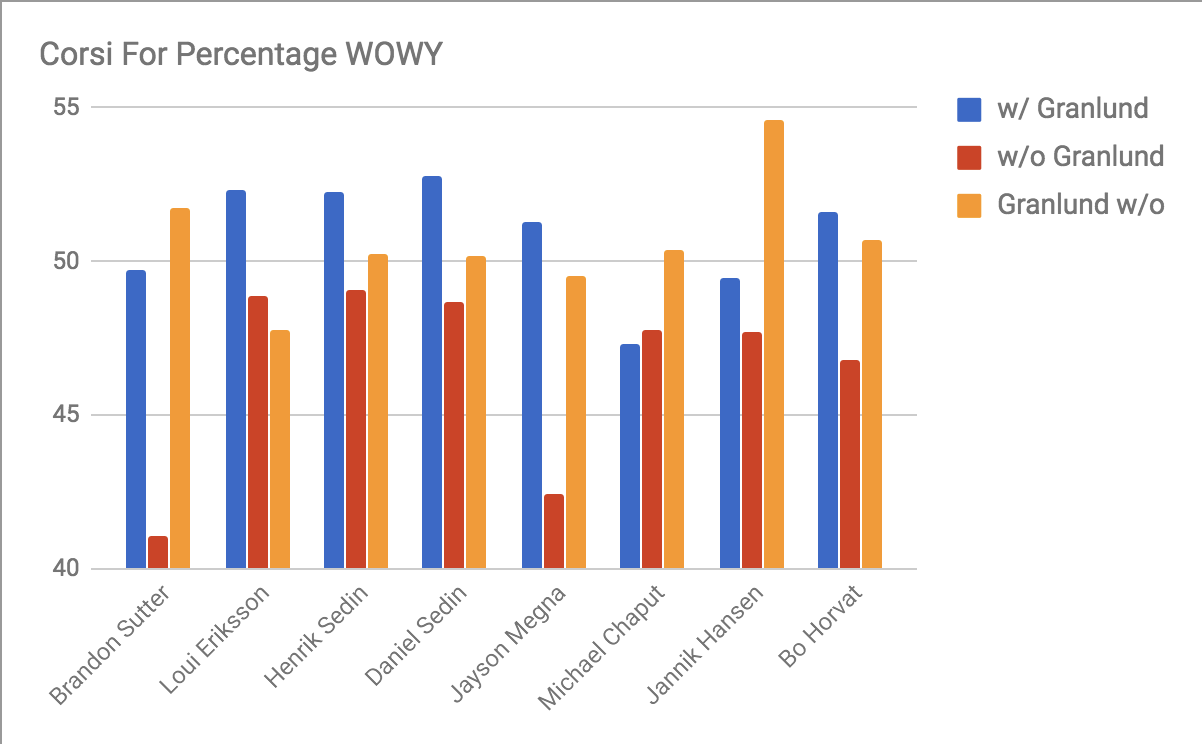Markus Granlund is not a big talker; he’s quiet and unassuming, though you can occasionally see a mischievous side peek out. You quickly discover that the best way to find out about Granlund is to ask someone else. When you do, there are two words that get mentioned repeatedly.
Smart. Versatile.
It’s that intelligence and versatility that . Of the Sedins’ wingers, Granlund was second behind Loui Eriksson in corsi percentage and Daniel Sedin, when asked about wingers he enjoyed playing with, immediately brought up Granlund.
“He’s a really smart player,” said Daniel Sedin. “PK, power play, if we’re up a goal, or down a goal, he can be in all those situations. He can skate, he can shoot, he can pass, I think he does it all really well.”
That versatility, however, is one of the things that will keep him off the Sedins’ line to start the season. So far in the preseason, new head coach Travis Green has been playing Granlund at centre. Meanwhile, Thomas Vanek has played with the Sedins, a line combination whose walk-out music would have been Handel’s “Hallelujah Chorus” about five years ago, but now has even Green concerned about their foot speed.
“Little bit. Yeah,” he says, laughing. “They’re definitely not the fastest line, but one thing I’ve noticed from the start of camp to today is [Vanek] is skating a lot faster. I’ve been surprised. Our coaches have been surprised. So we’ll see.”
It’s become clear that Green prefers to keep things unclear when it comes to his lineups, but when it comes to Granlund, he prefers to have him at centre for now.
“I like Granlund’s game right now, he’s played well in the middle so I have him still at centre,” he says. “I think Granlund’s a guy that is one of those guys that can play all over.”
Before coming to the Canucks, Granlund had never played a full season on the wing. While he played there on occasion, he was mostly used at centre all through junior. And, when he got to the NHL with the Calgary Flames, it was also at centre. He scored 14 goals and 28 points in his 86 games with the Flames and combined them with appallingly bad underlying statistics.
Just 15 NHL forwards played 500+ minutes in the 2014-15 season and had a worse corsi percentage (shot-attempt differential) than Granlund. When the Canucks traded for him during the 2015-16 season, he was dead last on the Flames in fenwick percentage (unblocked shot-attempt differential). After the trade, he didn’t get any better: in his 16 games with the Canucks, Granlund was dead last in both corsi and fenwick percentage.
That’s what makes his 2016-17 season so surprising. It wasn’t just that he scored 19 goals in heavy usage, or that he killed penalties, or that he was versatile enough to play on any line; it was that his underlying puck possession numbers underwent a complete reversal.
Only three players appeared in 50+ games with the Canucks last season and posted a positive shot-attempt differential: Brendan Gaunce, Loui Eriksson, and Granlund. Travis Green highlighted an aspect of Granlund’s game that helps explain why.
“Just details,” he said. “Little details that until you watch a game and break down video, people don’t see. He’s in the right spot a lot of times.”
Those little details show up in a big way when you look at his impact on his linemates. Whatever line Granlund played on, he provided a boost to their corsi.

Ěý
The graph above shows Granlund’s eight most frequent linemates last season at 5-on-5. The blue bar is their corsi percentage together, the red bar is the linemate’s corsi percentage away from Granlund, and the orange bar is Granlund’s corsi percentage away from that linemate.
You can see that with just one exception, Granlund’s linemates put up a better corsi percentage with Granlund than they did without. And again, with just one exception, Granlund did better away from each of those linemates as well.
The biggest differences are seen with Brandon Sutter and Jayson Megna. Together, Granlund and Sutter had a 49.75% corsi, nearly breaking even in shot attempts when on the ice together 5-on-5. Away from Granlund, Sutter had a 41.05% corsi. He got crushed.
With most of those linemates, Granlund posted a corsi percentage above 50%, meaning the Canucks had more shot attempts than their opposition when he was on the ice with that linemate 5-on-5. All of those eight players have a corsi percentage below 50% without Granlund.
This shows Granlund’s versatility, as he boosted every line he played on. Whether it was an offensive-minded line like the Sedins or a shutdown line with Sutter, Granlund made them better.
The intriguing thing is that he did that boosting from the wing. When we think of possession-driving forwards, we usually think of centres. Possession-driving wingers seem to be a lot more rare. It’s no wonder that Green looks at Granlund and sees a centre. The massive difference in his underlying numbers from his 86 games at centre with the Flames to last season on the wing with the Canucks should perhaps give Green pause.
“I look at everything, but analytics are not everything,” said Green. “I try to take in information, though.”
As for Daniel, even if he would prefer to have Granlund on his wing, he looks forward to seeing what he can do at centre.
“I think he’s a really good centreman,” said Daniel. “I think he can carry a line himself. I’m sure things are going to change throughout the year but it’s good to see him at centre. I don’t think we’ve seen him enough at centre. It’ll be a good fit.”
Granlund himself seems content to play wherever Green wants him. When asked why Green wants him at centre, he shrugs and says, “Probably my 200-feet game.” He doesn’t elaborate.
But when I mention Daniel’s comments about him being smart and carrying a line, he smiles.
“It means a lot if a player like that says something about you,” he says. “They’re such smart players, I think you’ve got to be a smart player if you want to play with them.”
“If you’re a centre, you have to be a leader of your line,” he continues. “You’ve gotta run the line. You show on the ice what’s going on.”
As for his underlying possession statistics, Granlund pays no attention to them. He doesn’t need to know his corsi or fenwick to know how well he’s playing.
“I know if I have a good game or not, I can feel it in my body,” he says. “I know what’s going on.”
Ěý



